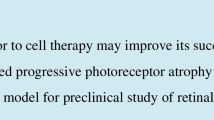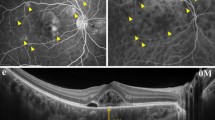Abstract
Purpose
To examine the effects of surgical removal of the retinal pigment epithelium (RPE) on the choroidal circulation of the rabbit.
Methods
The retina and choroid were examined by biomicroscopy, scanning laser ophthalmoscopy, fluorescein and indocyanine green angiography and histology at various times after the surgical removal of the RPE by gentle aspiration following a prior local vitrectomy and bleb detachment. Comparison was made between small and large areas of RPE removal, or only slight pressure to the retina without removal of RPE.
Results
Removal of the RPE layer causes transient leakage of vascular fluid into the subretinal space for at least a week after surgery and loss of perfusion in the underlying choroidal vessels and choriocapillaris at the débridement site. This reduction in local choroidal blood flow can occur within 15 min after RPE débridement and can be transient or permanent. Histology indicates that permanent changes are due to fibroblastic infiltration that compresses the choroidal vessels. Permanent changes tend to occur after removal of relatively large areas of RPE. The removal of small areas of RPE or slight pressure on the retina causes a transient loss of local choroidal perfusion, and fibroblastic infiltration into the choroid does not occur.
Conclusion
Removal of the RPE causes changes throughout the underlying choroid. It reduces the circulation in the large choroidal vessels as well as the choriocapillaris. If large areas of RPE are removed, this choroidal non-perfusion can be permanent due to fibroblastic infiltration. Small areas of RPE removal or slight pressure on the retina lead to only transient reduction of the choroidal flow. The rapidity with which the choroidal blood flow can be reduced implies a reflex mechanism that responds to sudden RPE pressure and/or trauma. These changes are best observed with ICG angiography.











Similar content being viewed by others
References
Binder S, Stolba U, Krebs I, Kellner L, Jahn C, Feichtinger H, Povelka M, Frohner U, Kruger A, Hilgers RD, Krugluger W (2002) Transplantation of autologous retinal pigment epithelium in eyes with foveal neovascularization resulting from age-related macular degeneration: a pilot study. Am J Ophthalmol 133:215–225
Chang AA, Morse LS, Handa JT, Morales RB, Tucker R, Hjelmeland L, Yannuzzi LA (1998) Histologic localization of indocyanine green dye in aging primate and human ocular tissues with clinical angiographic correlation. Ophthalmology 105:1060–1068
Del Priore LV, Hornbeck R, Kaplan HJ, Jones Z, Valentino TL (1995) Debridement of the pig retinal pigment epithelium in vivo. Arch Ophthalmol 113:939–944
Del Priore LV, Kaplan HJ, Hornbeck R, Jones Z, Swinn M (1996) Retinal pigment epithelial debridement as a model for the pathogenesis and treatment of macular degeneration. Am J Ophthalmol 122:629–643
Fluegel C, Tamm ER, Mayer B, Lutjen-Drecoll L (1994) Species differences in choroidal vasodilative innervation: Evidence for specific intrinsic nitrergic and VIP-positive neurons in the human eye. Invest Ophthalmol Vis Sci 35 (2):592–599
Heriot WJ, Machemer R (1992) Pigment epithelial repair. Graefes Arch Clin Exp Ophthalmol 230:230–291
Korte GE, Reppucci V, Henkind P (1984) RPE destruction causes choriocapillary atrophy. Invest Ophthalmol Vis Sci 25:1135–1145
Leonard DS, Zhang X, Panozzo G, Sugino IK, Zarbin MA (1997) Clinicopathological correlation of localized retinal pigment epithelium debridement. Invest Ophthalmol Vis Sci 38:1094–1109
Lopez PF, Yan Q, Kohen L,Rao NA, Spee C, Black J, Organisian A (1995) Retinal pigment epithelial wound healing. Arch Ophthalmol 113:1437–1446
Nilsson SFE, Linders J, Bill A (1985) Characteristics of uveal vasodilation produced by facial nerve stimulation in monkeys, cats and rabbits. Exp Eye Res 40:841–852
Valentino TL, Kaplan HK, Del Priore LV, Fang S, Berger A, Silverman MS (1995) Retinal pigment epithelial repopulation in monkeys after submacular surgery. Arch Ophthalmol 113:932–938
Wang H, Leonhard DS, Castellarin AA, Tsukahara I, Ninomiya Y, Yagi F, Cheewatrakoolpong I, Sugino IK, Zarbin MA (2001) Short-term study of allogeneic retinal pigment epithelium transplants onto debrided Bruch's membrane. Invest Ophthalmol Vis Sci 42:2990–2999
Author information
Authors and Affiliations
Corresponding author
Rights and permissions
About this article
Cite this article
Ivert, L., Kong, J. & Gouras, P. Changes in the choroidal circulation of rabbit following RPE removal. Graefe's Arch Clin Exp Ophthalmol 241, 656–666 (2003). https://doi.org/10.1007/s00417-003-0653-5
Received:
Revised:
Accepted:
Published:
Issue Date:
DOI: https://doi.org/10.1007/s00417-003-0653-5




